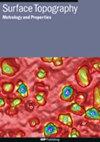The microhardness, morphology and tribological property of TC4 subjected to machine hammer peening
IF 2
3区 材料科学
Q2 ENGINEERING, MECHANICAL
引用次数: 0
Abstract
Ti alloy has become an indispensable material in harsh working environments due to its excellent wear resistance, corrosion resistance and impact resistance. These environments place stringent requirements on the fatigue life, friction and wear, and surface strength of materials. Therefore, this study aims to deeply explore the surface mechanical properties of Ti-6Al-4V (TC4) alloy after machine hammer peening (MHP) treatment. By conducting experiments on TC4 alloys treated with different hammering energies, the changes in surface hardness, morphology, roughness, tensile properties, and friction properties were analyzed, and the strengthening mechanism of MHP was discussed. Experimental results show that MHP treatment can effectively improve the surface properties of TC4. With the increase of hammer energy, due to the double-sided hammering of the plate, the microhardness first increases, then decreases, and then rises again. The tensile strength and yield strength of the sample increase slightly, but the elongation at break decreases. The surface roughness of the sample increases first and then decreases. Similarly, after MHP treatment, the wear resistance of the samples increased, the friction coefficient decreased, and the wear amount and surface height difference showed a trend of first increasing and then decreasing. The wear mechanism mainly included adhesive wear, abrasive wear and fatigue wear.经过机锤强化处理的 TC4 的显微硬度、形貌和摩擦学特性
钛合金具有优异的耐磨性、耐腐蚀性和抗冲击性,已成为恶劣工作环境中不可或缺的材料。这些环境对材料的疲劳寿命、摩擦磨损和表面强度提出了严格的要求。因此,本研究旨在深入探讨 Ti-6Al-4V (TC4) 合金经过机锤强化(MHP)处理后的表面机械性能。通过对不同锤击能量处理后的 TC4 合金进行实验,分析其表面硬度、形貌、粗糙度、拉伸性能和摩擦性能的变化,并探讨 MHP 的强化机理。实验结果表明,MHP 处理能有效改善 TC4 的表面性能。随着锤击能量的增加,由于板材的双面锤击,显微硬度先升高、后降低、再升高。试样的抗拉强度和屈服强度略有增加,但断裂伸长率有所下降。试样的表面粗糙度先增大后减小。同样,经过 MHP 处理后,样品的耐磨性增加,摩擦系数降低,磨损量和表面高度差呈先增大后减小的趋势。磨损机理主要包括粘着磨损、磨料磨损和疲劳磨损。
本文章由计算机程序翻译,如有差异,请以英文原文为准。
求助全文
约1分钟内获得全文
求助全文
来源期刊

Surface Topography: Metrology and Properties
Materials Science-Materials Chemistry
CiteScore
4.10
自引率
22.20%
发文量
183
期刊介绍:
An international forum for academics, industrialists and engineers to publish the latest research in surface topography measurement and characterisation, instrumentation development and the properties of surfaces.
 求助内容:
求助内容: 应助结果提醒方式:
应助结果提醒方式:


